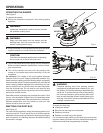
13
OPERATION
WARNING:
Collected sanding dust from sanding surface
coatings such as polyurethanes, linseed oil, etc., can
self-ignite in the sander dust bag or elsewhere and
cause fire. To reduce the risk of fire, always empty
the dust bag frequently while sanding and never
store or leave a sander without totally emptying its
dust bag. Also follow the recommendations of the
coatings manufacturers.
To empty the dust bag:
Unplug the sander.
Remove the dust bag from the sander.
Shake out the dust.
Reattach the dust bag to the sander.
For a more thorough cleaning of the dust bag, remove dust
bag from frame and shake out dust. Replace dust bag over
frame then install dust bag assembly on sander.
OPERATING THE SANDER
See Figure 9.
To operate the sander:
Secure the workpiece to prevent it from moving during
operation.
WARNING:
Unsecured workpieces could be thrown towards
the operator causing injury.
WARNING:
Keep your head away from the sander and the
sand ing area. Your hair could be drawn into the
sander, causing serious injury.
Place the sander on the workpiece so that all of the sand-
ing disc surface is in contact with the workpiece.
CAUTION:
To avoid motor damage resulting from overheating,
do not cov er the air vents with your hand.
Turn on the sander and move it slowly over the workpiece.
Make successive passes in parallel lines, circles, or cross-
wise movements.
Turn off the sander and wait until the sanding disc
comes to a complete stop before removing it from the
workpiece.
Do not force. The weight of the unit sup plies ad e quate
pres sure to do the work. Ap ply ing additional pressure only
slows the motor, rap id ly wears the sanding sheet, and greatly
reduces sander speed. Excessive pressure will over load the
motor causing pos si ble damage from over heat ing and can
result in inferior work. Any finish or resin on wood may soften
from the frictional heat. Do not sand on one spot too long
as the sander’s rapid action may remove too much material,
making the sur face uneven.
Extended periods of sanding may over heat the mo tor. If this
occurs, turn the sander off and wait until the sanding sheet
comes to a complete stop. Remove sander from workpiece.
Remove sanding disc, then turn sander on, and run it free
without a load to cool the motor.
EMPTYING THE DUST BAG
See Figure 10.
For more efficient operation, empty the dust bag when it is no
more than half full. This will permit the air to flow through the
bag better. Always empty and clean the dust bag thoroughly
upon completion of a sanding operation and before placing
the sander in storage.
Fig. 9
KEE
P
C
LEA
R
A
I
R
FL
O
W
KE
EP CLE
A
R
AI
R FLO
W
AIR VENTS
Fig. 10
DUST BAG


















